DGA 2020-2025 Survey and Focus Group (English and Spanish)
Generic Clearance to Conduct Formative Research/CNPP
Attachment A-2 Discussion Guide (English) clean OCIO 081120
DGA 2020-2025 Survey and Focus Group (English and Spanish)
OMB: 0584-0523
OMB CONTROL NO.: 0584-0523
EXPIRATION DATE: 11/30/2022
OMB BURDEN STATEMENT: According to the Paperwork Reduction Act of 1995, no persons are required to respond to a collection of information unless it displays a valid OMB control number. The valid OMB control number for this information collection is 0584-0523 and the expiration date is 11/30/2022. The time to complete this information collection is estimated at 2 hours, including 30 minutes for logging into the online platform, reviewing instructions, and completing the information. Send comments regarding this burden estimate or any other aspect of this collection of information, including suggestions for reducing this burden, to: U.S. Department of Agriculture, Food and Nutrition Services, Braddock Metro Center II, 1320 Braddock Place, Alexandria, VA 22314, ATTN: PRA (0584-0523). Do not return the completed form to this address.
Attachment A-2 Discussion Guide (English)
(Pregnant Women)
Focus Group Moderator Guide
Target Time ≈ 2 hours (including 30 minutes to log on)
Introduction (10 minutes]
Moderator introduces herself
Remind respondents to be in a quiet place
If you need to step away, do so briefly and come back as soon as possible
Anonymity
Rules for participation online (all opinions count, no wrong answers)
One point you may notice about everyone participating today is that everyone is pregnant. We will talk about what that’s like in a few different areas of the discussion, and even though that is the case, we all do not have to agree, nor do we have to find consensus. Please share your honest thoughts and impressions.
Grab a few pieces of paper and a pen or pencil.
Introduction – Share your first name, where you live, with whom you live (people, pets, plants, etc.), and what, if anything, you had for breakfast today.
Warm-Up & Food Decision-Making for the Pregnant Woman (20 minutes)
To start, take a moment and think of a word or phrase you would use to describe what life is like these days.
[MODERATOR GO AROUND SCREEN]
Why that word or phrase?
We are going to make a list. I am going to give you a word, and I want you to type all of the words and phrases that come to mind when I say that word. We’ll have about 30 seconds to type our words and phrases into the chat box. What are the words and phrases that come to mind when I say, “healthy eating”?
[MODERATOR TO ALLOW UNAIDED RESPONSE]
[GO AROUND SCREEN:] What were the first few words/phrases that came to your mind? Why those?
When, if at all, do you think about healthy eating?
For yourself?
For members of your family?
How much, if at all, do you think about healthy eating when it comes to the foods you choose to eat?
How does that compare with the thought you give to beverages you drink during a day? [PROBE: more/less likely to do so food vs beverage; or at different times of the day]
Specifically, what are you thinking when it comes to healthy eating? In the chat function, type what, if anything, you think about when it comes to deciding what to eat or drink. If you typically don’t think about it, just type that into the chat box. If you think about only one thing or two things, just write those.
[GO AROUND SCREEN:] What did you type?
Why those? What about those things makes you think about them when making decisions about what you eat and drink?
Now a different question. On a scale of 1 to 5, where a 1 means it is very difficult, and a 5 means it is very easy, and you can use any number from 1 to 5, how easy/difficult is it to make sure that you are “eating healthy”?
GO AROUND SCREEN
How much do you care about that right now? What makes you say that?
What’s difficult? What are the harder parts about making sure you are eating healthy? [PROBE: Changing information/information sources]
[IF NECESSARY:] What are the barriers that make it difficult for you to eat healthy?
What would help you to eat healthier?
What specific elements of eating healthy are you most concerned about?
[IF NECESSARY:] In other words, what are some things, if any, you want to make sure you get enough of?
[IF NECESSARY:] What are some things, if any, that you want to limit?
Currently, where do you get this information about what you should eat and drink?
How do you get this information? How often?
Which websites, apps, or devices help you?
Nutrition Trajectory (5-10 minutes)
Let’s change the question a bit. When you think about your approach to healthy eating, is it something that has pretty much been the same or has it changed over time?
In other words, have there been times in your life when you were more focused on healthy eating than you are now?
[IF YES:] When were those times?
[IF YES:] What about those times made you more focused on healthy eating?
[IF NO:] Why do you think that is?
[IF TIME:] Have there been times in your life when you were less focused on healthy eating than you are now?
[IF YES:] When were those times?
[IF YES:] What changed? What about those times made you less focused on healthy eating?
[IF NO:] Why do you think that is?
Have you ever thought about healthy eating in this way, as in, over the course of your lifetime? How does it make you feel?
How important is it to think about it in this way? What makes you say that?
What comes to mind when I say the phrase, “life stage”? What about “stage of life”?
To what extent, if at all, do you think your “life stage” affects how much you focus on healthy eating? What makes you say that?
What are some of the “influencers” that might lead to your changing your approach to healthy eating? [LISTEN FOR: Significant other, upbringing, personal preference]
Language/Concept Testing (20 minutes)
A. Thanks for that
information. Now, we’re going to look at a few different
sentences, and I want to get your reactions and interpretations of
the information in each sentence.
MODERATOR WILL ROTATE SENTENCES ACROSS GROUPS TO GET REACTIONS.
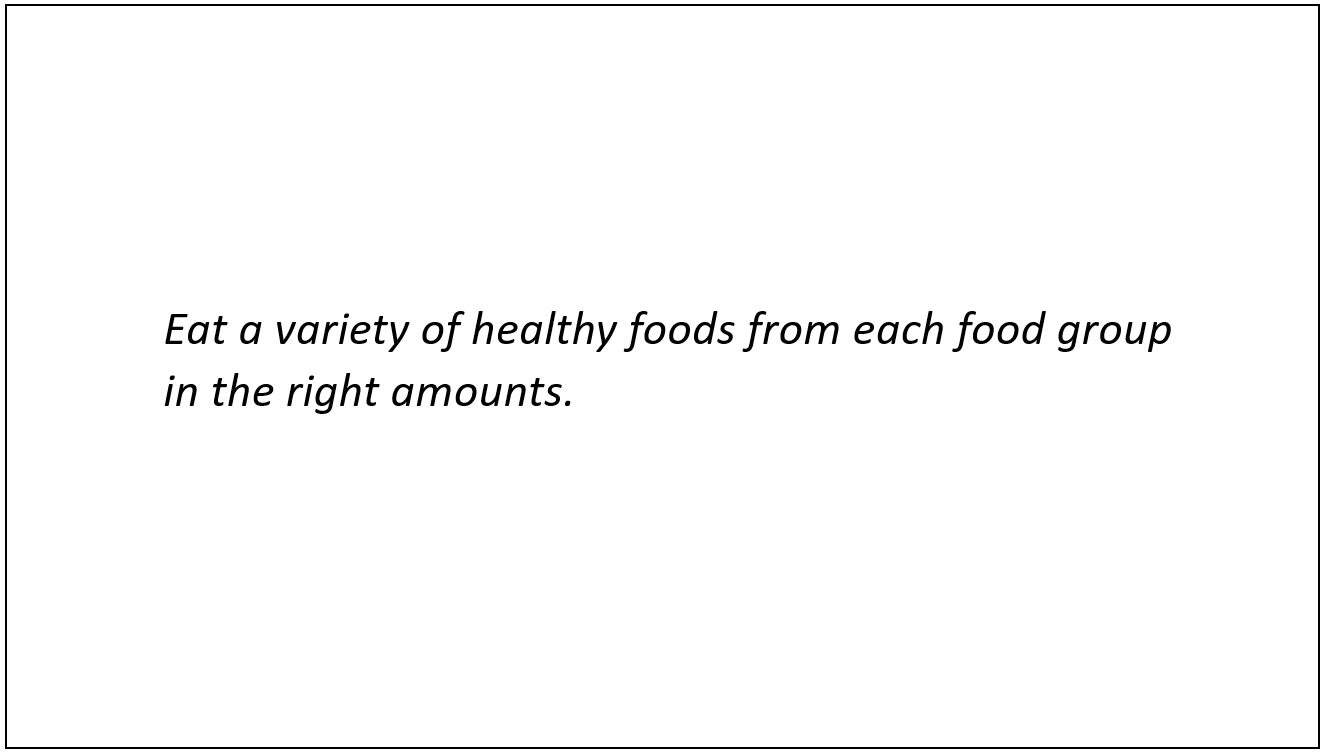
Language displayed on the computer screen during the focus group for participants to read and discuss.
“Eat a variety of healthy foods from each food group in the right amounts.”
What is this sentence asking you to do?
In the chat box, put this sentence in your own words, without using the term, “variety”. MODERATOR REVIEW RESPONSES
Does it seem like it would be easy or hard to do what this sentence suggests?
What makes you say that?
Let’s say you were going to try to do what this sentence suggests. How, if at all, do you think it would change the decisions you make about what to eat and drink?
PROBE: Eating from new food groups
PROBE: Eating more than you normally eat?
What does it mean to eat “the right amounts”?
What is your reaction when you see this phrase?
This sentence also uses the term, “food groups.”
Are you familiar with the term?
Is it a term you still use?
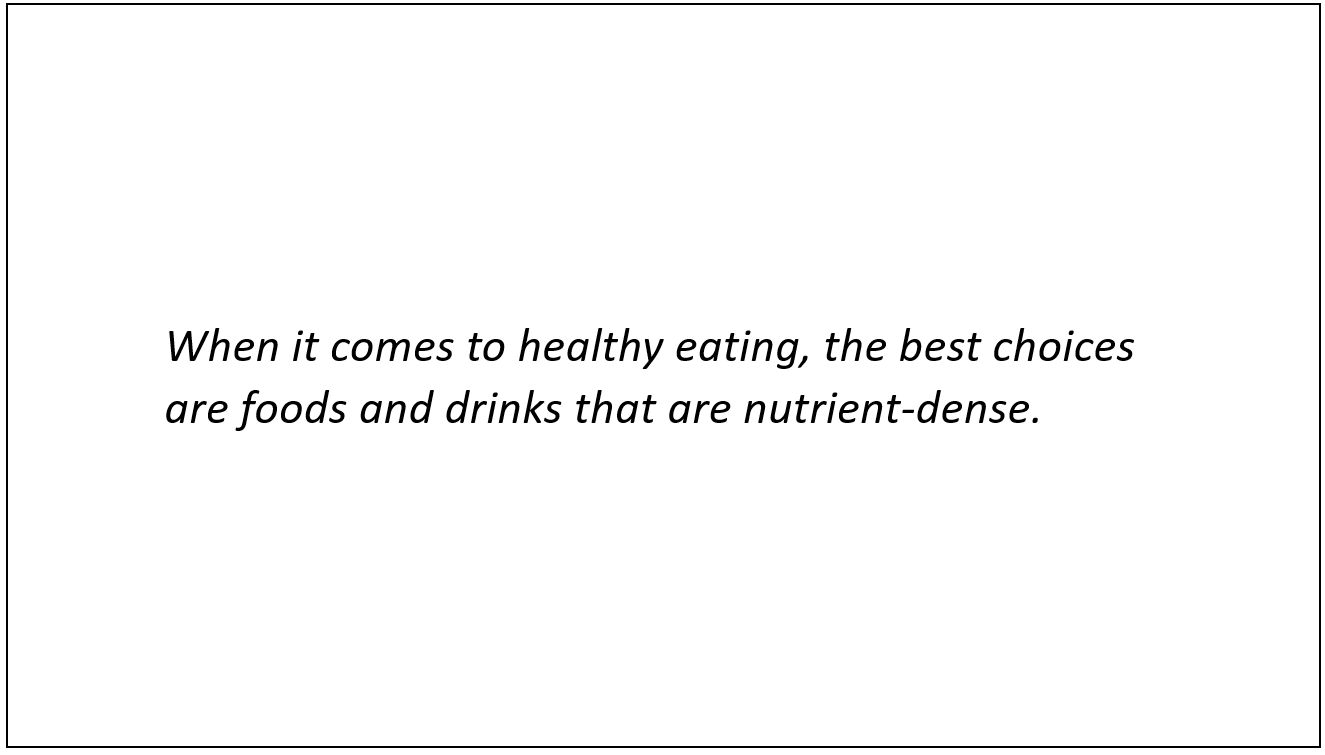
Language displayed on the computer screen during the focus group for participants to read and discuss.
“When it comes to healthy eating, the best choices are foods and drinks that are nutrient-dense.”
What does this sentence mean? How would you rephrase it in your own words?
[IF NOT NOTED IN RESPONSE TO PREVIOUS QUESTION:] What does it mean when a food is “nutrient-dense”?
Is this a good thing or a bad thing?
By a show of hands, how many of you have heard the term, “nutrient density”?
What are some examples of foods or beverages that are nutrient-dense?
How do you know they are?
[MODERATOR SHOW ON SCREEN] On the screen, you will see three different phrases that could be used to communicate this idea. Which one would you be most likely to use—nutrient-dense; nutrient-packed; quality calories?
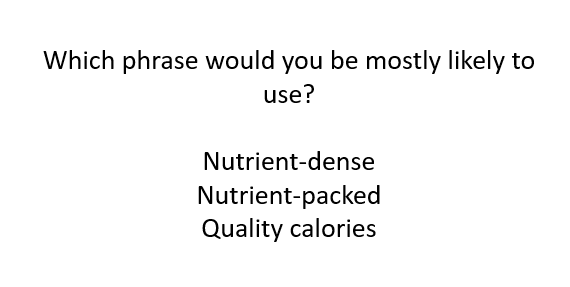
Language displayed on the computer screen during the focus group for participants to read and discuss.
ALLOW RESPONDENTS TO VOTE, SHARE TALLY
Which phrase did you select? What makes you say that?
Is there another term you would use?
Or, do you even need a term? How would you explain this idea with your friends?
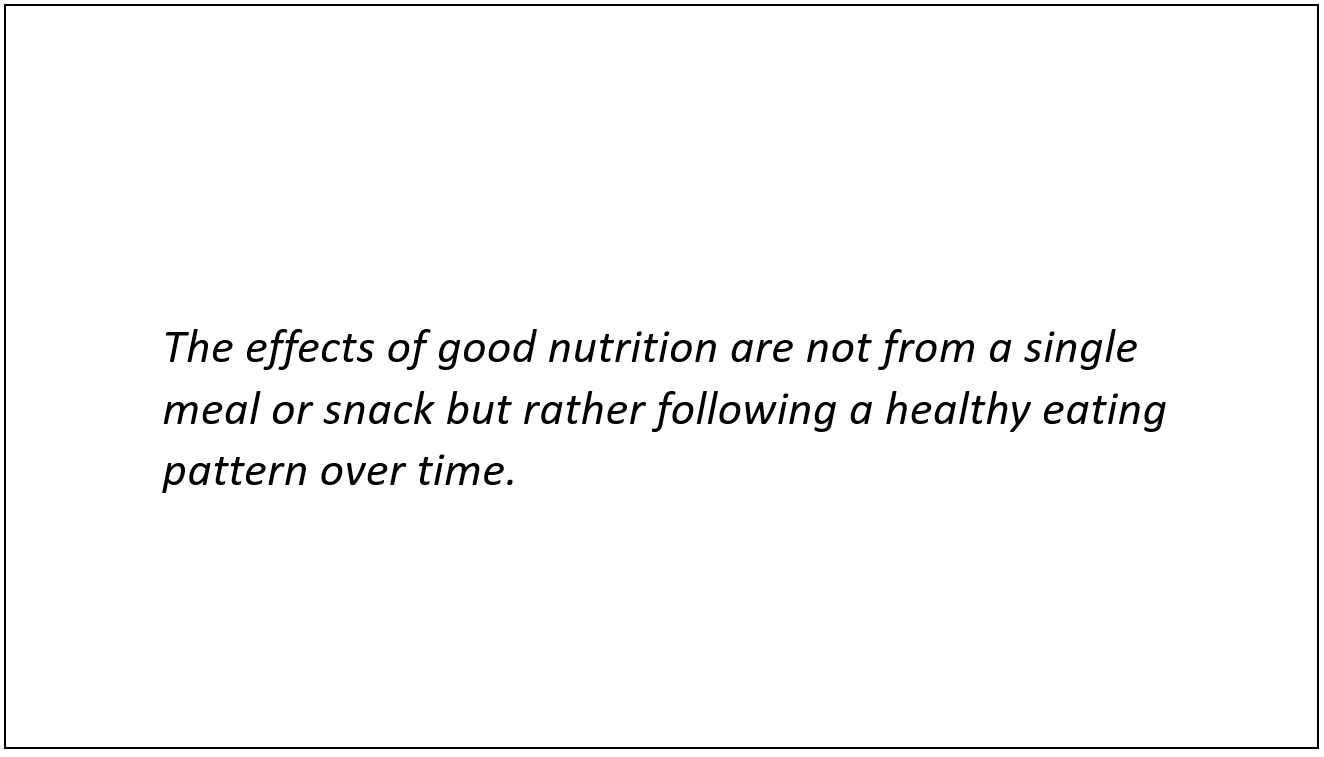
Language displayed on the computer screen during the focus group for participants to read and discuss.
“The effects of good nutrition are not from a single meal or snack but rather following a healthy eating pattern over time.”
What does this sentence mean? How would you rephrase it in your own words?
[IF NOT NOTED IN RESPONSE TO PREVIOUS QUESTION:] What is a healthy eating pattern?
A “healthy eating pattern” is supposed to communicate the idea of regularly making healthy food and drink choices. What is your reaction to this idea?
[MODERATOR SHOW ON SCREEN] On the screen, you will see three different phrases that could be used to communicate this idea. Which one does the best job of capturing the idea of regularly making healthy food and drink choices—healthy eating pattern; healthy eating routine; healthy eating habits?
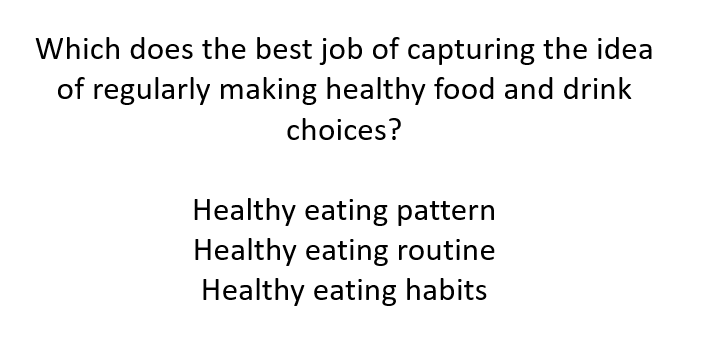
Language displayed on the computer screen during the focus group for participants to read and discuss.
ALLOW RESPONDENTS TO VOTE, SHARE TALLY
Which phrase did you select? What makes you say that?
What elements would you have to keep in mind or take into account to make sure you were following a healthy eating pattern?
[IF NECESSARY:] Actually, a healthy eating pattern includes all of the elements we just discussed—variety, selecting foods and beverages that are nutrient-dense, and eating foods in the right amount. What is your initial reaction to this information?
Does this seem doable? Impossible? What makes you say that?
Which of the three do you think is the most important? What makes you say that?
Which of the three would be the easiest for you to do, starting today? What makes you say that?
Does a healthy eating pattern/routine/habits seem to allow you to be flexible in your choices? What makes you say that?
What about personalization?
Does it seem as though you could personalize your choices in your healthy eating pattern/routine/habits? What makes you say that?
How important is it for you to be able to personalize your choices when it comes to healthy eating? What makes you say that?
Dietary Guidelines Message Drill-Down (25 minutes)
A. Now we are going to
talk about something a bit more specific. I am going to show you
some recommendations that are going to be part of the 2020
Dietary Guidelines for Americans.
The Dietary
Guidelines for Americans
are our nation’s national food and nutrition recommendations.
They tell us what and how much people should eat and drink every day
to be healthy. This year’s recommendations are going to
include specific recommendations for women who are pregnant.
Before I share the recommendations, have any of you heard of the Dietary Guidelines for Americans?
What about MyPlate.gov?
[SHOW MYPLATE LOGO ON SCREEN AND ASK AGAIN]
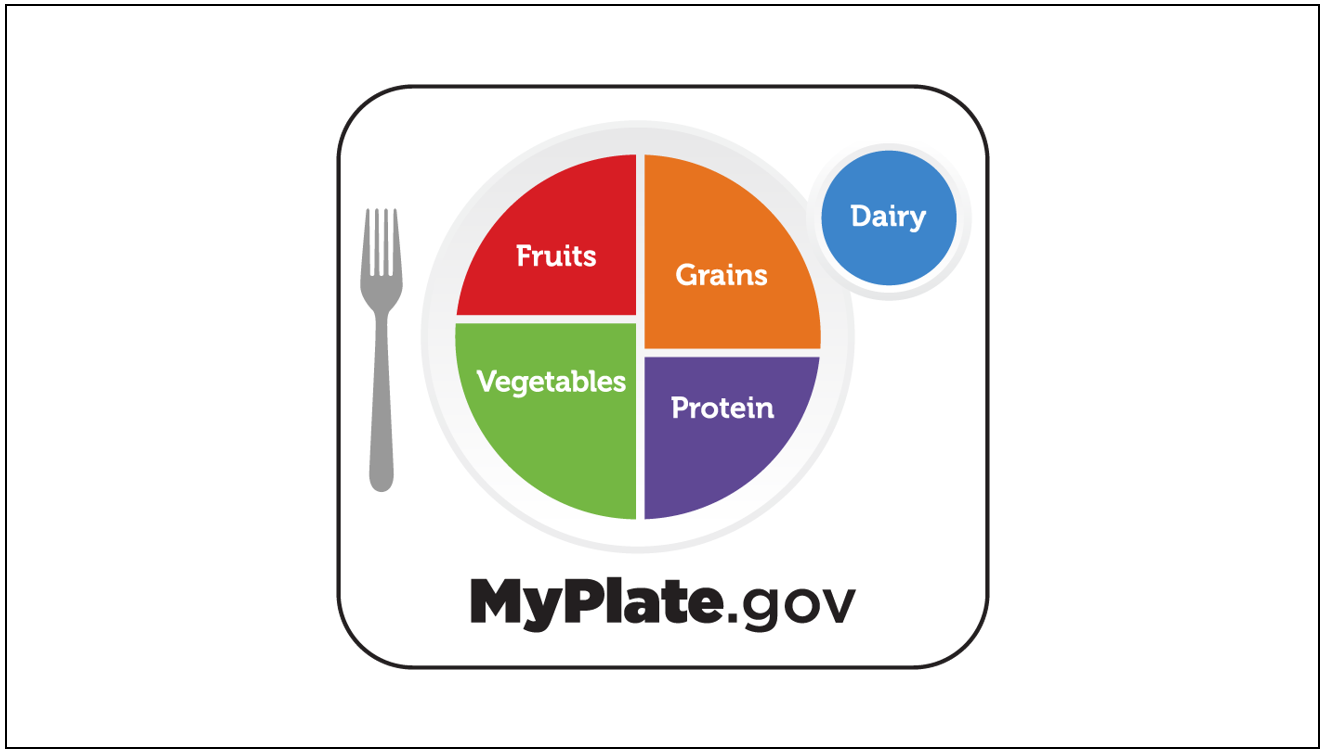
Image displayed on the computer screen during the focus group for participants to read and discuss.
The information in MyPlate incorporates the recommendations in the Dietary Guidelines.
Take a look at the screen, and you will see a list of recommendations for women who are pregnant. Take a moment, and on your scratch sheet of paper write down anything that jumps out at you in a positive or negative way. Also write down anything that seems confusing. Then, we’ll talk about it. [SHOW RECOMMENDATIONS ON SCREEN]
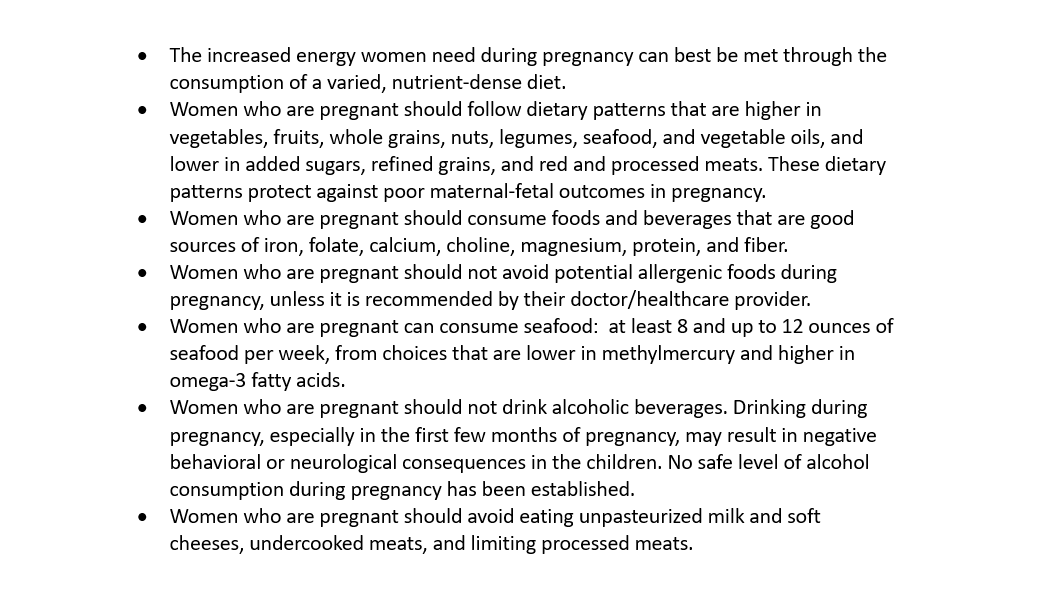
Language displayed on the computer screen during the focus group for participants to read and discuss.
The increased energy women need during pregnancy can best be met through the consumption of a varied, nutrient-dense diet.
Women who are pregnant should follow dietary patterns that are higher in vegetables, fruits, whole grains, nuts, legumes, seafood, and vegetable oils, and lower in added sugars, refined grains, and red and processed meats. These dietary patterns protect against poor maternal-fetal outcomes in pregnancy.
Women who are pregnant should consume foods and beverages that are good sources of iron, folate, calcium, choline, magnesium, protein, and fiber.
Women who are pregnant should not avoid potential allergenic foods during pregnancy, unless it is recommended by their doctor/healthcare provider.
Women who are pregnant can consume seafood: at least 8 and up to 12 ounces of seafood per week, from choices that are lower in methylmercury and higher in omega-3 fatty acids.
Women who are pregnant should not drink alcoholic beverages. Drinking during pregnancy, especially in the first few months of pregnancy, may result in negative behavioral or neurological consequences in the children. No safe level of alcohol consumption during pregnancy has been established.
Women who are pregnant should avoid eating unpasteurized milk and soft cheeses, undercooked meats, and limiting processed meats.
What is your reaction to this information? How do you feel after reading it?
Have you heard this information before? From whom?
[PROBE: healthcare providers, OB-GYNs]
What, if anything, seems different from what you have heard/read elsewhere? Does it feel repetitive?
What, if anything, did you have a positive reaction to? Why?
What, if anything, did you have a negative reaction to? What, specifically, caused that reaction?
What, if anything, seems confusing?
Of the ones that are listed there, which one would be the hardest for you to do? What makes that one the hardest?
What would be most helpful to you to make it easier to follow these recommendations?
MODERATOR, AS TIME ALLOWS AND IF NOT PREVIOUSLY MENTIONED, PROBE ON THE FOLLOWING:
One of the recommendations suggests, “The increased energy women need during pregnancy can best be met through the consumption of a varied, nutrient-dense diet.”
Take a moment, and in the chat function, can you put this recommendation in your own words? What do you think it is trying to say?
REVIEW RESPONSES
Another recommendation suggests that pregnant women “follow dietary patterns…”
What does this recommendation mean to you?
What steps, if any, would you need to take to follow this recommendation?
What additional information would be helpful to you to make it easier to follow this recommendation?
One of the recommendations is, “Women who are pregnant should not avoid potential allergenic foods during pregnancy, unless it is recommended by their doctor/healthcare provider.”
What is your reaction to this recommendation?
How likely are you to try to follow this recommendation? What makes you say that?
Is this new information, or have you heard it before now? From where?
What do you think about the recommendation to avoid alcoholic beverages?
What is your initial reaction?
How likely are you to try to follow this recommendation?
Is this new information, or have you heard it before now? From where?
There is also a recommendation about weight gain.
To what extent, if at all, are you concerned about weight gain during pregnancy?
What information would be helpful to you in this area?
Before we move to the next section, I have one more idea to share with you:
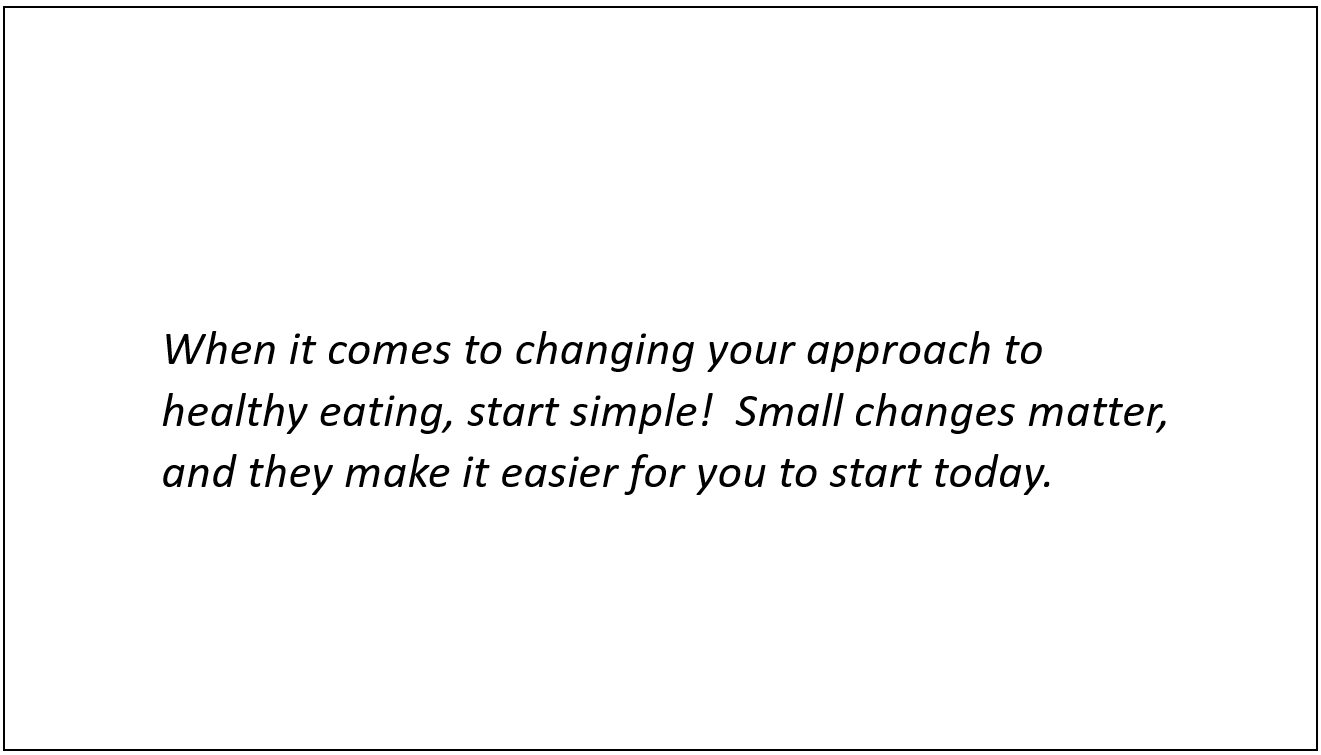
Language displayed on the computer screen during the focus group for participants to read and discuss.
When it comes to changing your approach to healthy eating, start simple! Small changes matter, and they make it easier for you to start today.
What is your reaction to this idea?
Does it seem realistic?
Keeping in mind the three ideas we have been discussing, do you think it is possible to “start simple”?
What assistance/information would you need to help you to “start simple”?
Wrap-up/False Close (5 minutes)
Thank you for all of the information you have provided.
Earlier, I mentioned that MyPlate.gov incorporates the Dietary Guidelines. This year represents the first time the Dietary Guidelines is including recommendations for pregnant women, as well as for babies and toddlers 0-24-months in age. As a result, MyPlate is considering an additional logo to represent this information, specifically. Take a look at the screen. It includes an idea for the logo. It is not finished. It was just designed for this conversation.
SHOW LOGO ON SCREEN
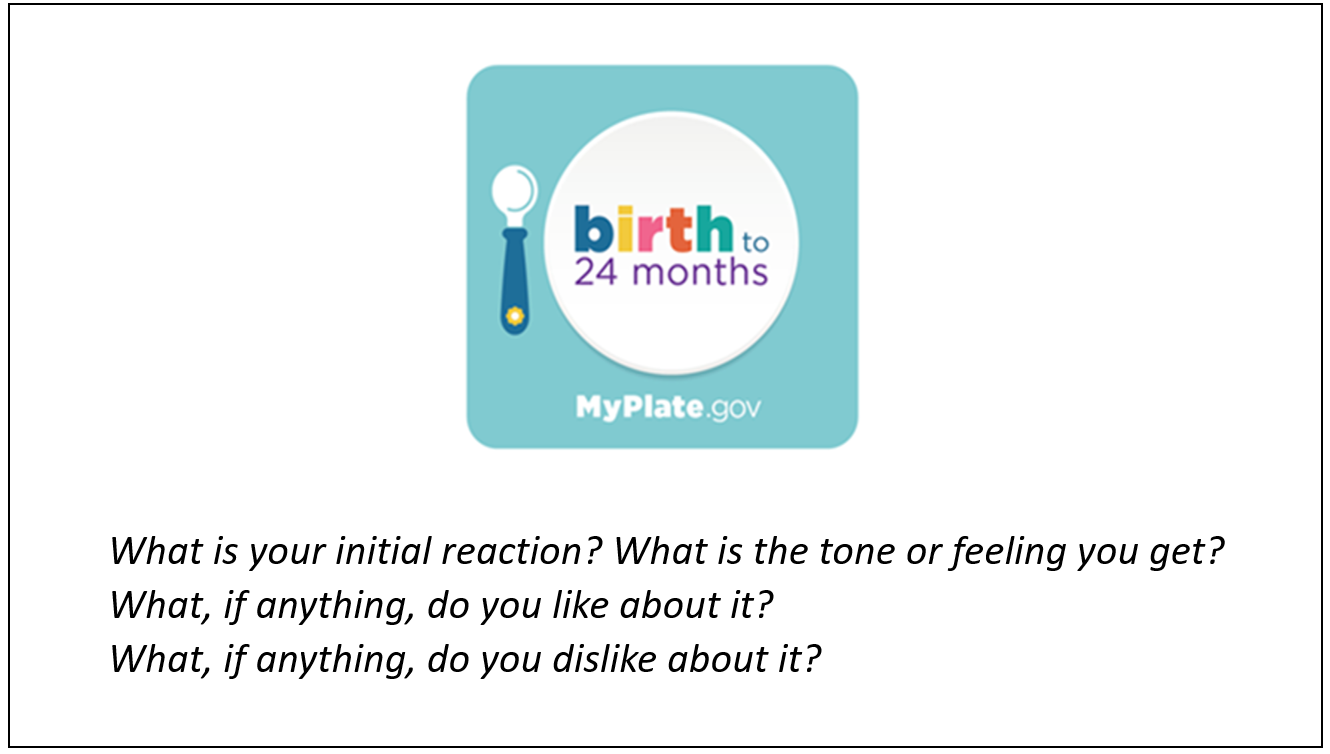
Language
and image displayed on the computer screen during the focus group for
participants to read and discuss.
While I check with my colleagues to make sure they do not have any additional questions, please look at the screen and answer the questions you see there about the logo.
What is your initial reaction? What is the tone or feeling you get?
What, if anything, do you like about it?
What, if anything, do you dislike about it?
Thanks again! Have a great evening.
Privacy Act Statement:
Legal Authority: The United States Department of Agriculture (USDA) Food and Nutrition Service (FNS) is authorized to collect this information under Section 19 of the Child Nutrition Act of 1966 (42 U.S.C. 1787), Section 5 of the Richard B. Russell National School Lunch Act (42 U.S.C. 1754) and Section 11(f) of the Food and Nutrition Act of 2008 (7 U.S.C.2020).
Purpose: This information will be used in to inform the 2020-2025 Dietary Guidelines for Americans about how Americans make food choices and think about health-related issues.
Routine Use: Information may be disclosed for any routine uses listed in the published System of Record Notice titled FNS-8 USDA/FNS Studies and Reports Federal Register published on April 25, 1991, Volume 56, Number 80, on pages 19078 discusses the terms of protections that will be provided to respondents.; the SORNs can be found at: https://tile.loc.gov/storage-services/service/ll/fedreg/fr056/fr056080/fr056080.pdf.
Disclosure: All information collected will be collected privately and only reported anonymously, without any associated with your information or personal information. Any information which would permit identification of the individual will be safeguarded and will be used only by persons engaged in and for the purpose of the survey, except as otherwise required by law.
Participation in this research is voluntary and there are no penalties for refusing to answer any question. However, your cooperation in obtaining this much needed information is extremely important in order to insure the completeness of the results.
| File Type | application/vnd.openxmlformats-officedocument.wordprocessingml.document |
| Author | Alec Ulasevich |
| File Modified | 0000-00-00 |
| File Created | 2021-01-13 |
© 2026 OMB.report | Privacy Policy